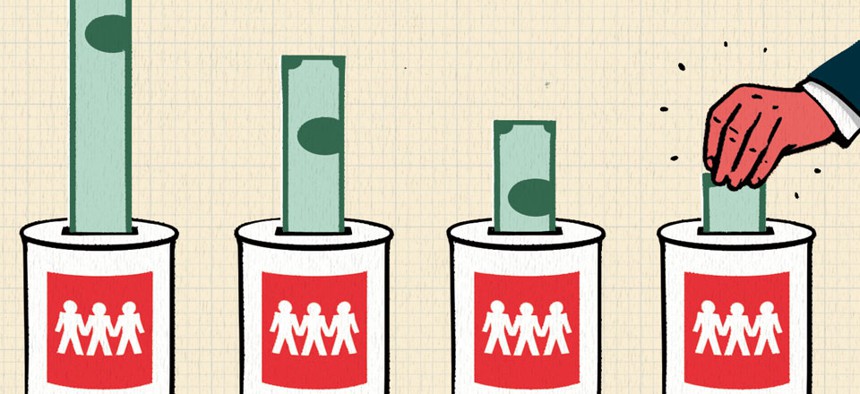
Chris Gash
Furloughs Test Spirit Of Giving
Charities brace for fewer donations to the Combined Federal Campaign after pay freezes, benefit cuts and a government shutdown leave the workforce wary.
Most years, retired Navy veteran Al Bennett and his wife, Betty Lou, drive their motor home from Arkansas to the Washington area to help Mercy Ships—a charity that sends hospital ships around the world—mobilize its efforts for the Combined Federal Campaign. This year, the Bennetts’ trip was in doubt after most of the early events to support the annual federal employee giving drive were canceled due to the government shutdown.
These events, organized at federal agencies throughout the country, help raise awareness for both participating charities and the campaign in general, stakeholders say. But the combination of fewer fundraisers and feds who were either working under the threat of delayed paychecks or furloughed and uncertain whether they would receive back pay has created a gloomy outlook for this year’s campaign.
“There are so many unknowns,” says Tom Youngblood, chief executive officer of Human Service Charities of America and Christian Service Charities, which help groups like Mercy Ships prepare for the CFC every year. “Obviously, it has an impact on our charities.”
This fall marked the start of the 52nd annual drive to solicit donations for thousands of charities worldwide, during what is normally a 10-week period but has been extended this year to Jan. 15 in light of the shutdown. Many federal employees enroll in a program to have their donations deducted from their paychecks.
As the shutdown dragged on through the early weeks of October, charities—especially those that rely heavily on the CFC for annual budgeting—feared many donors would not only decline to enroll for 2014, but cut back on pledges they had already made for the current year. Federal employees have endured three years of frozen pay, benefit cuts and furloughs from sequestration and the shutdown, and they can cut off their donations at any time.
Money raised for some of the participating charities, such as the Federal Employees Education and Assistance Fund, goes to helping government workers in financial distress. For these organizations, the shutdown presented a double-edged sword. “It’s often at the time that we need the most help that we find it the most difficult to raise money,” says Robyn Kehoe, a spokeswoman for FEEA, which brings in 15 percent to 20 percent of its annual revenues from the CFC. “It’s rare that a crisis would be affecting federal employees globally.”
FEEA was forced to cancel several CFC events during the shutdown, which lasted until Oct. 17. Even after employees returned to work they were focused on making up for missed time and couldn’t devote their usual attention to charitable giving, according to Kehoe. The organization, which offers no-interest loans to federal employees, was already short on cash after sequestration furloughs led to a wave of loan requests.
The shutdown came at a bad time for CFC charities, which have been experiencing declining participation for nearly a decade. In 2012, 848,000 employees donated $258 million to the CFC, down from 959,000 participants and $272 million in 2011, and the lowest totals since 2004. “Last year was a tough year,” says Kal Stein, head of EarthShare, which helps organize the CFC drive for the National Capital Area. “We were hoping to have the campaign get back ahead. This makes it tough.”
CFC is the single largest source of general operating support for many organizations across the country, according to Stein. These funds are not earmarked for any particular purpose, and allow charities to “keep the lights on,” he says.
Perhaps the shutdown’s most significant effect the on CFC is that people like the Bennetts could lose out on the opportunity to make an impact on local communities. “The shutdown is a domino effect,” Youngblood says. “A lot of pieces fall . . . federal employees are being robbed of something.”
NEXT STORY: Around Government







